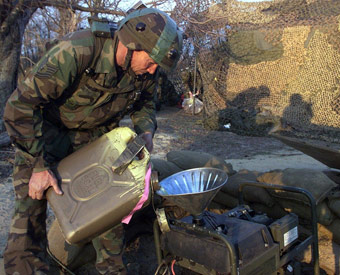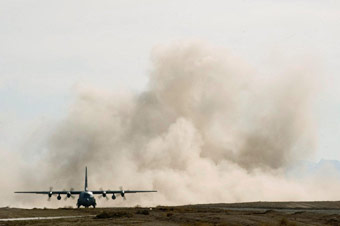Green Game Changers: Air Force Alternative Energy Research
The Air Force Research Laboratory’s Air Base Sciences Energy Group (AFRL/RXQ) is part of a larger effort to bring green energies into deployed settings like Afghanistan and Iraq using their existing power infrastructure of jet-fueled generators. These generators, which currently run full-out regardless of load, will soon become part of an in-theatre smart grid. Whether it’s solar, bio-algae or hydrogen fuel cells, the Air Force is learning to integrate green power production devices via storage to create a system with power conditioning and power correction. In other words, controllable power quality using distributed alternative energy will soon become a reality. And, this green game changer may just make it into mainstream society, or underdeveloped countries, in the not so distant future.
Energy storage, which is key for this system to work, can occur in a number of ways, such as chemically through a lithium or zinc bromide battery, mechanically through a fly-wheel, or electrically through a super-capacitor. Energy profile will determine storage type and when paired with better energy management techniques, this system will significantly reduce energy requirements. For instance, managing device start times, as well as when generators are brought on and off-line, will significantly reduce required generator capacity. And, stored energy from solar panels, or other alternative energy methods, can be used for peak management.
This system will also communicate with its individual components using the power cables themselves as the communication medium. According to Marcus D. Smith, AFRL’s MSEE Electrical Engineering Lead (Energy Group), “If you try to use wireless, a network cable or another communication method, you’re adding complexity to the base. However, if you put a power production or power draining device on either a load or a source, under our design it will immediately communicate with the control system to the grid and identify device type, priority, whether it’s a load or source and, if so, what it looks like and its usage profile. This type information would then be conveyed over the actual power cable to more efficiently and effectively manage the grid.”
Managing Standards, Sources & Real Estate
According to Smith, the Defense industry and civilian infrastructure need to develop standards so power system devices can speak the same language. Current commercial proprietary mindsets require systems to be designed for specific patented methods. Because AFRL/RXQ is not an equipment manufacturer, it can work more objectively to correct this problem. Therefore, it’s currently looking at different smart grid components in an effort to develop or to assist in the development of these standards. In addition, the Air Force has created a working group with the Department of Energy’s Sandia National Laboratories to further smart grid technology.
Since AFRL/RXQ’s intent is to connect all the devices in an intelligent way and then manage the load, it’s inherent that they also manage the sources. According to Smith, this means they must “figure out how to use and how to manage existing real estate. In the deployed environment, the Air Force puts down billeting tents, command centers and other infrastructure that we can use to generate energy. We’re looking at an amorphous silicone, which is a flexible solar panel that can wrap over the top of tents. We’ve done quite a bit of research into this area – working with different manufacturers to evaluate different flexible solar panels so we can effectively use the space on deployed bases.”

U.S. Air Force photo by Staff Sgt. Stan Parker
Solar panels on top of tents, or similar systems, will allow the Air Force to distribute energy throughout the base in the event of an emergency. If a base loses its generators, it will be able to continue to power critical systems. Distributed energy is a key component of the AFRL/RXQ system, especially considering their in-theatre power configuration. Currently, the Air Force’s main power system runs off a MEP-12 (Mobile Electric Power) – 750 kw generators bunched together, each burning 55 gallons of jet fuel (JP8) per hour. This three-phase, high-voltage system is the basis of the power grid system, spreading out in a branch topography to different end users.
Using Different Energy Systems
Smith explains that the Air Force operates their generator system “differently from the other Services, probably because we’re the only ones using high-voltage. Ours is three-phase, 4160 volts. The power comes off these generators and as it gets out to the tent level, we step it down to 208 volts. The higher the voltage, the more efficient the system. Conversely, lower voltages are largely inefficient, which makes spot power extremely inefficient. What happens with spot power is that each tent has to have a generator running all the time. The Air Force has all its generators together, which effectively creates a power plant. That allows us to monitor usage and to bring additional generators on as loading increases or decreases.
Our system has a back-up method for getting energy to tents – an SDC (Secondary Distribution Center) – and can input one of two ways. It can either take high voltage from the main generators or it can take a back-up generator at the lower voltage – the 208. So, our research effort is looking at integrating power in the low voltage area at tent level.”
The Air Force mission is different from the Army, Marines or Navy, which may explain the different way they “power up.” They must immediately construct a runway, which requires a larger contingent of people and equipment. In fact, a small deployed Air Force base, which includes 1100 men, runways and machine shops, is 10 times the size of the largest deployed Marine Corps base. Regardless of mission differences, Smith maintains that spot generation is still highly inefficient, which is why the Air Force “tries to get away from it. Both the Marines and Army deploy spot generation, but there’s no reason they have to. They can use a smart grid as well, which is why we’re working to make our system scalable. It can be used for a 50-man Marine detachment or an 1100-man Air Force detachment.”
 U.S. Air Force photo/Master Sgt. Adrian Cadiz |
An aircrew operating a C-130 Hercules prepares to depart Forward Operating Base Davis, Afghanistan, Feb. 16, 2011. Airmen from the 807th Expeditionary Air Support Operations Squadron at FOB Lagman ensured the dirt landing zone was safe for aircraft to land and depart. |
Understanding Energy Requirements
Priority power routing is a consideration when generating energy using solar and wind. Therefore, the AFRL/RXQ system is controlled by one central controller with distributed controllers throughout the base. If the central controller goes down, one of the distributed controllers becomes the master controller. Although the system contains multiple redundancies, complete redundancy on cabling is impossible. However, it is possible to lay additional key cable segments to direct power a different way should a portion of the base be cut-off. These type things are what AFRL/RXQ is looking at, including the logistics of having as much security from host nation power grids or large scale generators as possible. It wants to generate as much power as possible in-field while providing power to the grid without causing problems.
Smith maintains that the Air Force “will never power just completely with traditional renewables because of energy density. If you look at the amount of power from a kilogram of jet fuel compared to a kilogram of photovoltaic material, jet fuel has a much higher energy density. That’s why some of our programs are aimed at algae; we want to break away the oils from algae and create an alternate power source. We want to use algae as our fuel base and supplement it with renewables, such as solar and wind, which will provide differentiated types of distributed energy. And, because the grid is smart, it can harness these power sources spread throughout the base and put them on board. If half the base gets blown-up, we’ll still be able to run our critical systems by pulling resources from remaining areas. If we do it this way, we can split up the generators and spread them throughout the base, rather than having them clustered together in a farm. Smart distributed energy capacity will provide additional deployed energy security.”
AFRL/RXQ is looking at a five-year program for this energy system deployment, which includes the different technologies. Some technologies will come on-line immediately while others will come on board later. This is one reason why researchers are looking at scalability. The first priority is to conquer the intelligence of the system, with the low hanging fruit being integration. This will allow the Air Force to immediately save large quantities of fuel.
Powering Fixed Installations

©iStockphoto.com/3dbrained
AFRL/RXQ is testing their new energy technology on fixed installations within the United States. Besides their large solar power array at Nellis Air Force Base, they are running several micro-grid experiments. According to Smith, “We’re part of JCTD – Joint Capabilities Technology Demonstration – at Ft. Irwin’s National Training Center in California. Even on military installations inside the US, we want to get away from single point failures ‘over the fence.’ The Air Force doesn’t control anything coming over the fence onto its installations. Our mentality is that if we don’t control it, then our enemies potentially can. Therefore, we need to have the capability to generate our own electricity to power mission critical centers should a power failure occur for whatever reason.”
The AFRL/RXQ energy system could be a model of energy independence for communities or individual houses. They, too, could be managed by a similar smart grid that utilizes diverse renewables. To do so, the US needs to develop standards for energy integration at the house level. According to Smith, the Japanese government is already on-board with this type system. He maintains that “they’ve worked through some of the issues with distributed systems already. There are some IEEE standards for ‘islanding’ where an inverter (the device that takes DC energy and converts it to AC energy) senses when the grid goes down and it disconnects from the grid so energy can’t energize supposedly dead lines and cause safety issues for power line workers. You would still have power at your local level but be unable to send power back onto the grid.”
Generating Power Wirelessly
AFRL/RXQ is also doing research in wireless power. Currently, they’re testing a system that uses infrared lasers to send power up to a kilometer away to power security sensors for deployed bases. However, this type process can be used on a much larger scale. According to Smith, wireless power can be sent in different ways, such as through a microwave or light wave. For a microwave, researchers use equipment to shape the beam so that it’s highly directionalized. Then they use a rectifying antenna to take the energy coming in on the microwave and convert it to electricity. A more efficient system, and one easier to work with and currently fielded by AFRL/RXQ, is lasers using photovoltaic material specifically designed to work at the wavelength of light researchers are interested in.
Smith explains that a solar cell is about 16 percent efficient compared with their laser energy system, which uses a wavelength of light that’s almost 60 percent efficient. Although Nikola Tesla posited the original idea of sending power wirelessly, a practical system has yet to be developed and implemented. Trials and tests have come and gone as interest has waxed and waned, which means this alternative power source may require the right situation coupled with enough public interest to make it happen. Unfortunately, Americans have yet to understand the true cost of resources they consume, particularly with respect to energy generation, which makes this one area where Americans are in need of a culture change. Smith concurs, saying that changing culture is one of AFRL/RXQ and the Air Forces’ key objectives, along with providing technology so that changes can be practically realized.
According to Smith, “As with America at large, the Air Force has run into some pushback with changing culture, but what’s nice is that many people are changing their thinking and support’s been building. In the three years that I’ve been working on AFRL/RXQ energy research, I’ve seen a real culture change. I believe people need to see and/or understand sustainability’s direct relevance in order to make positive change.”
Understanding Opportunities & Altering Perceptions
AFRL/RXQ’s joint capabilities energy study at Ft. Irwin is an example of changing culture. The military services came together to test their new technologies, bringing with them Flag and General officers seeking to learn as much as possible about alternative capabilities. The military now boasts a “community of interest,” with researchers from the Air Force, Navy, Marines and Army working side-by-side. In fact, one of the Marine researchers Smith works with is from the National Security Space Office, which is exploring power from space.

© iStockphoto.com/Mlenny
Smith explains that this is “an idea that’s been kicked around since the late 1970s – using a large solar array in space to harness energy. The atmosphere degrades power levels, but in space you can capture energy directly from the sun and then change the energy downlink wavelength to the area of the spectrum that’s impervious to water vapor and oxygen contamination. This effectively shifts energy to a new wavelength that can get through the atmosphere, and then you send that down to Earth.
This is a very doable challenge, but there are some roadblocks along the way, such as ferrying the equipment into space. Right now, it’s cost-prohibitive to send a large enough array into space to make this work. But, we’re working with NASA and the Jet Propulsion Lab putting together a few experiments. Although this may be workable for the future, it’s definitely not in our five-year or less roll-out plan like some of our other energy research.”
Although AFRL/RXQ’s new technology is specifically for Forward Operating Bases (FOBs), it could be used for fixed installations. These solutions are presented to each base power manager, who then decides, in conjunction with the Air Force Civil Engineer Support Agency (AFCESA), if the installation should use them. DoD requires each military installation to produce a certain percentage of its energy from renewables, which means energy managers are aggressively seeking new technologies. According to Smith, that’s “where AFRL/RXQ comes in to help because we’re a broker for new energy systems. We help base managers sort through credible technologies so they can generate their own on-base renewables.”
AFRL/RXQ is focused on getting systems into the field so the warfighter can keep his/her lights on. However, as mentioned, these type systems could be used for fixed installations, non-military communities or individual homes. They could even be successfully deployed to underdeveloped countries or during natural disasters, such as Hurricane Katrina or Haiti, to generate energy locally. AFRL/RXQ’s game changing energy technology may not only become an integral part of DoD’s energy revolution, it may also become part of America’s green revolution. It may even become part of the US military’s wider ideology and, hopefully, overarching US ideology to provide humanitarian relief and assistance that supports and promotes worldwide sustainability.




























